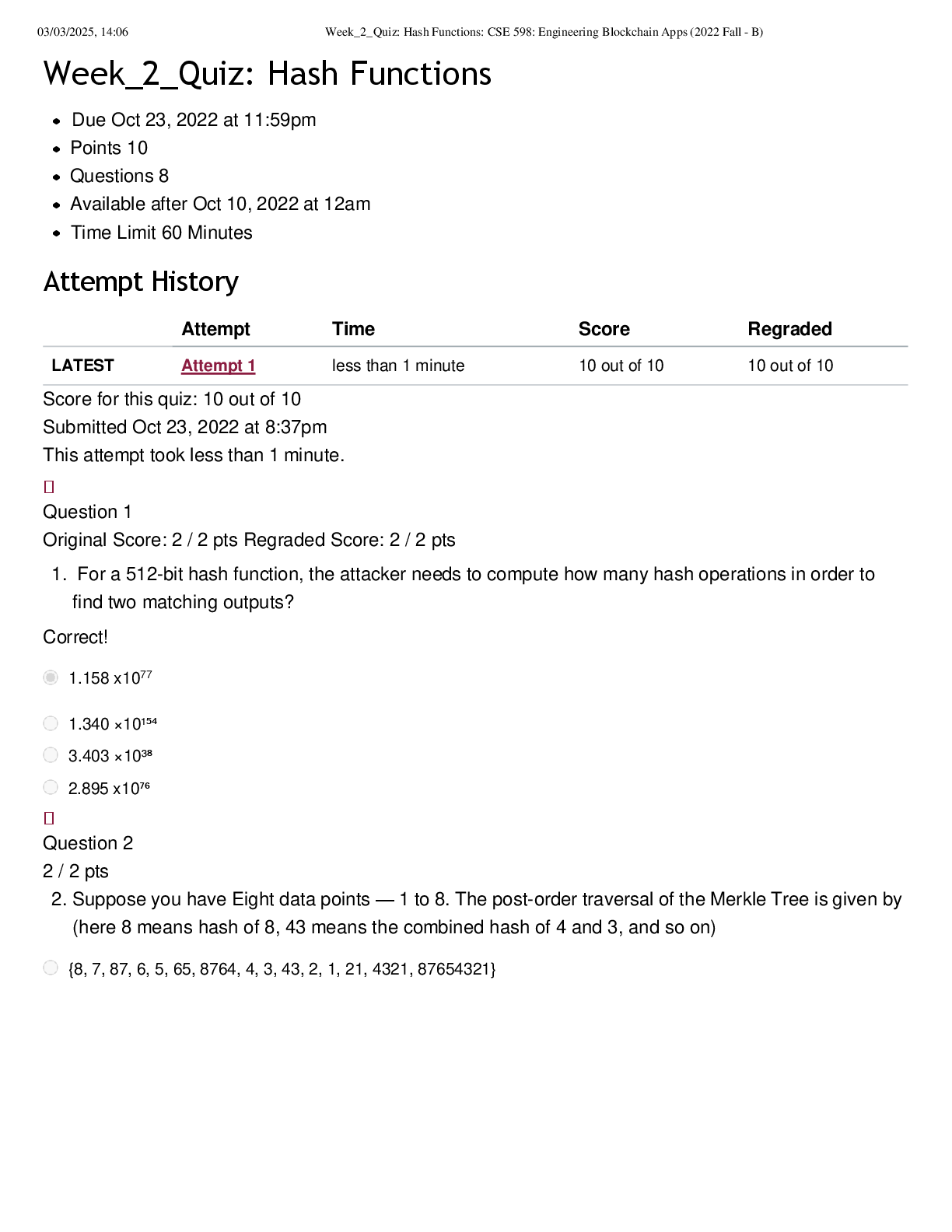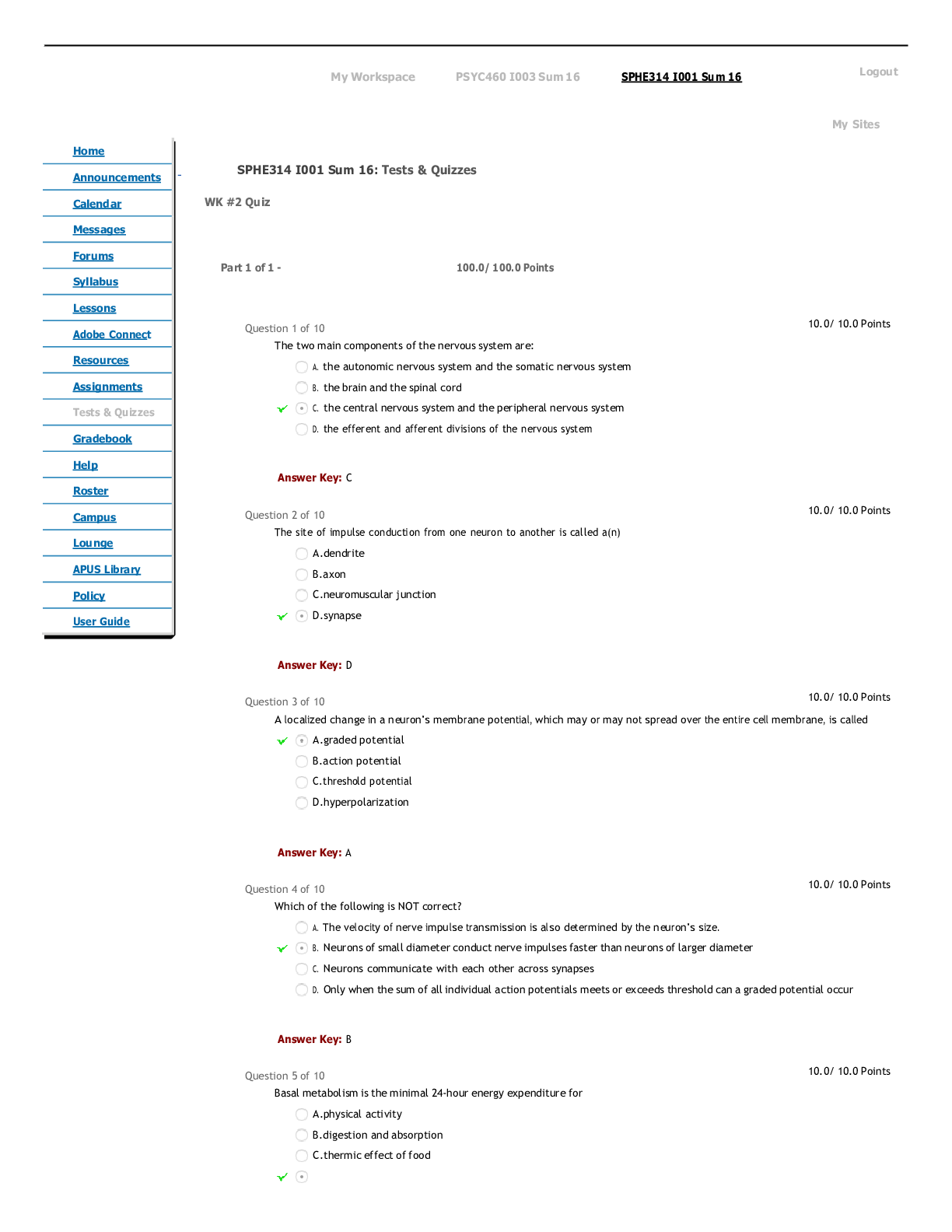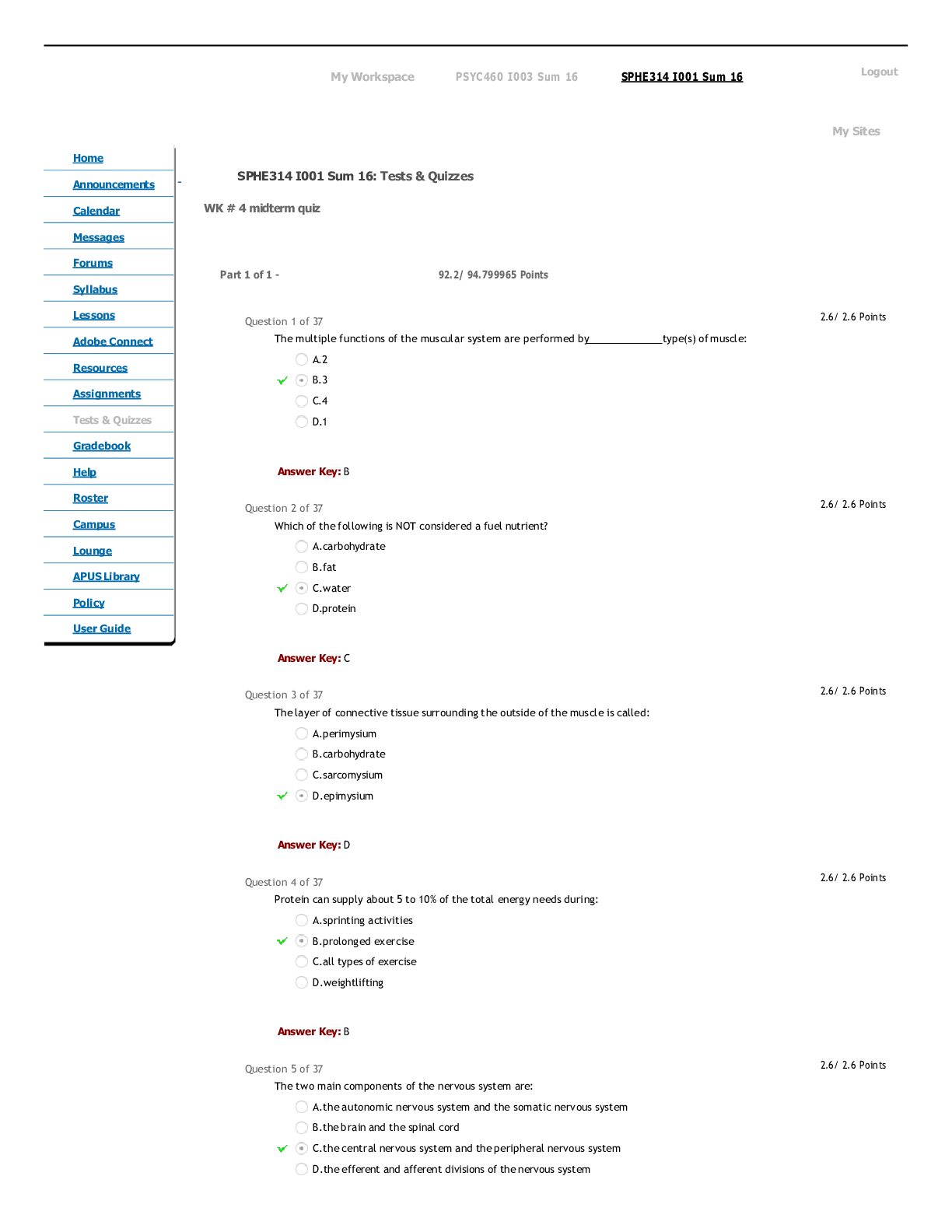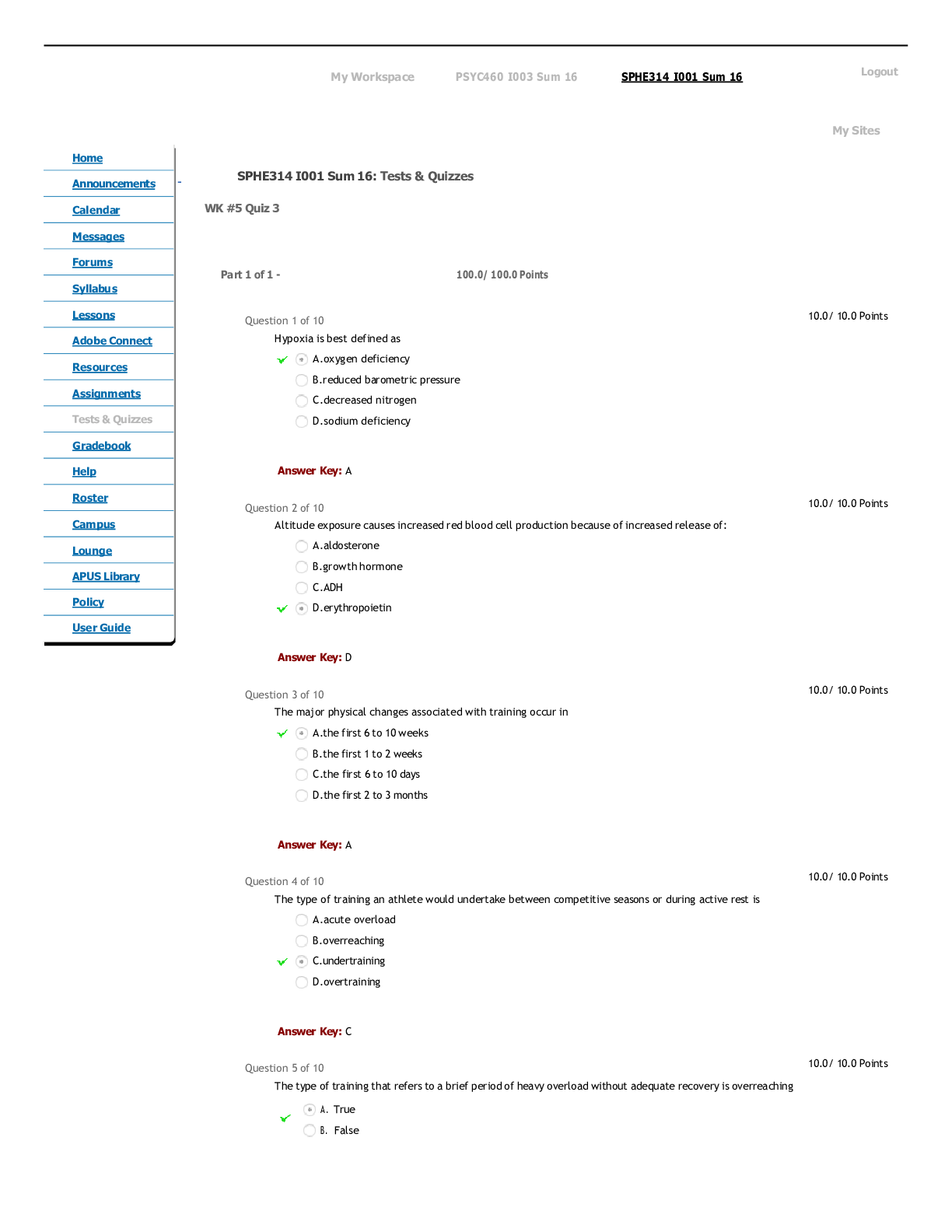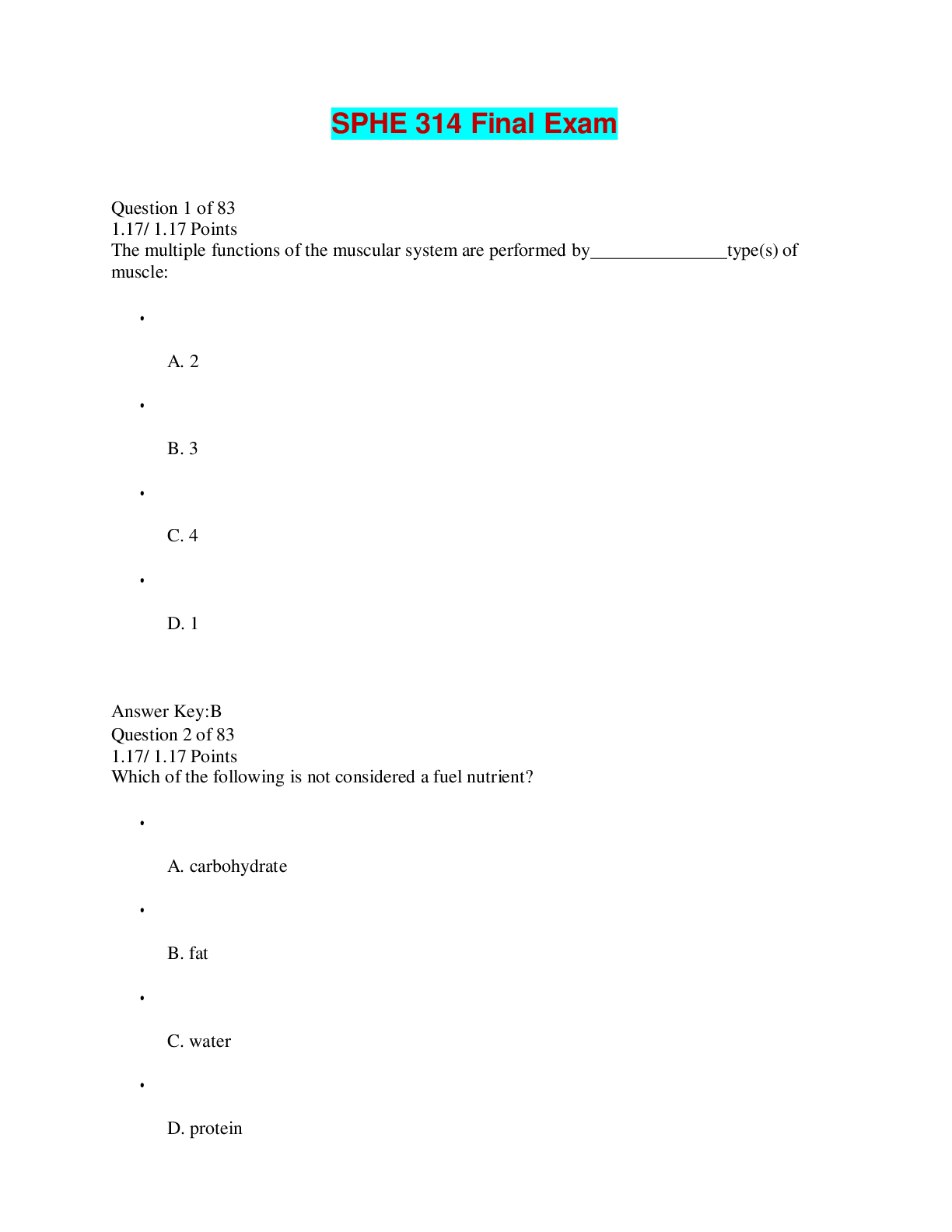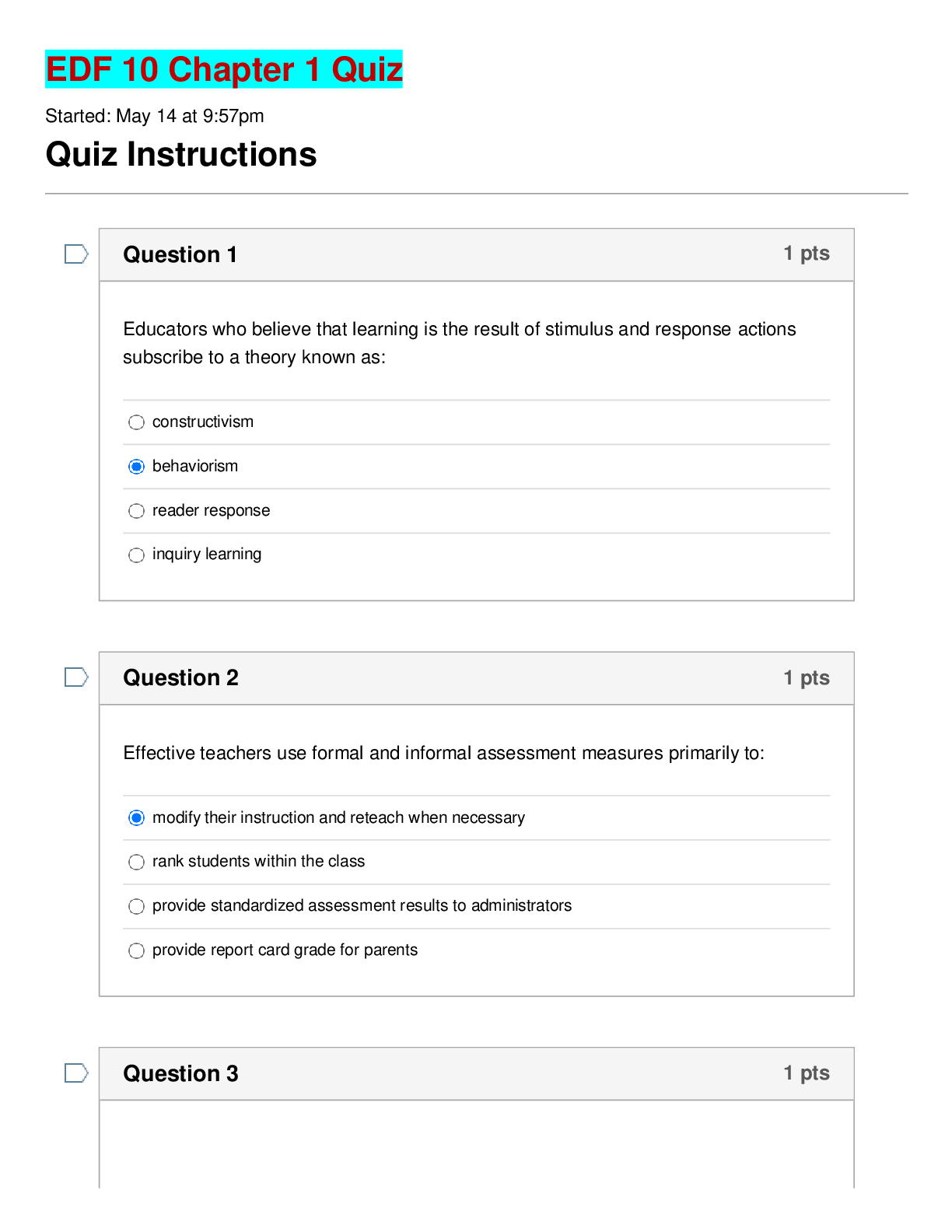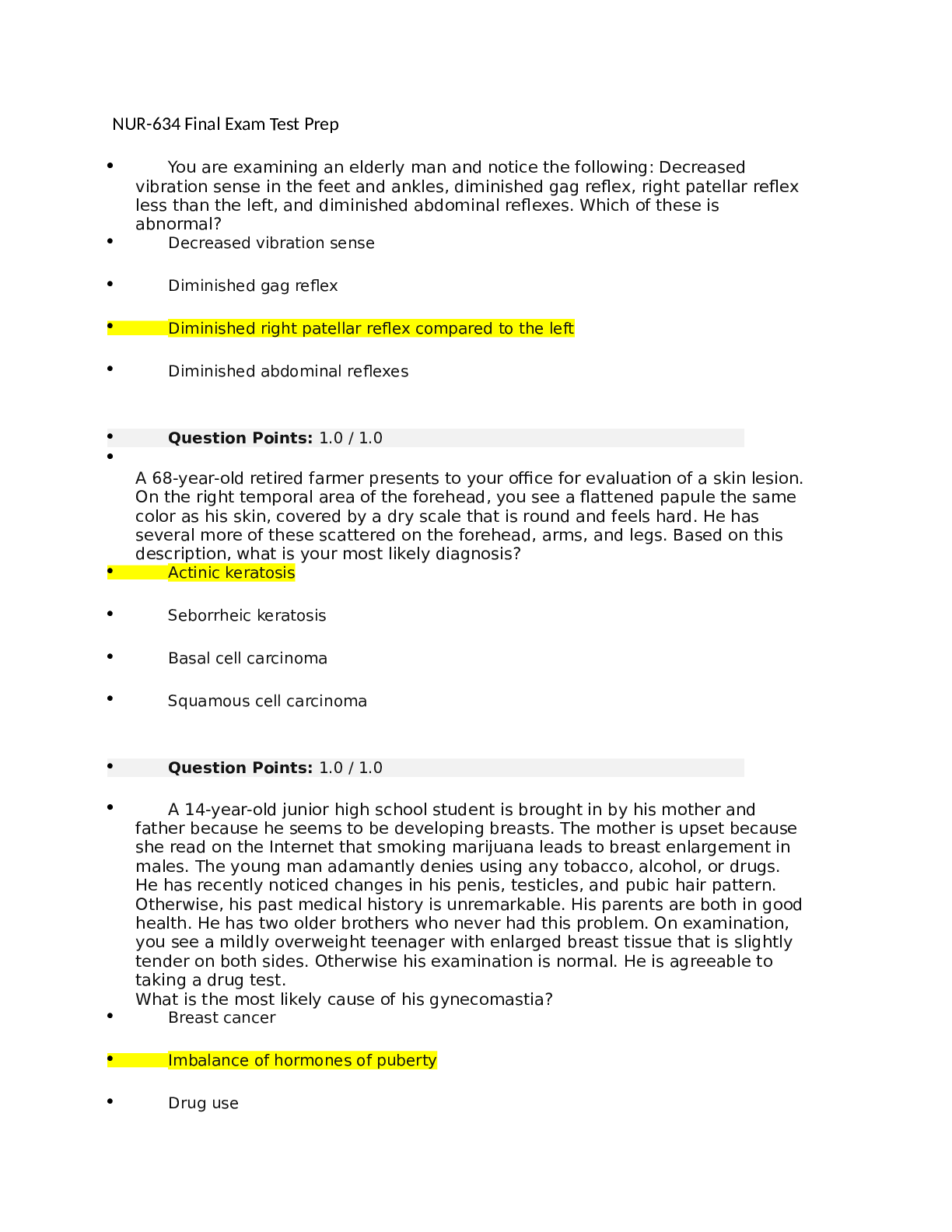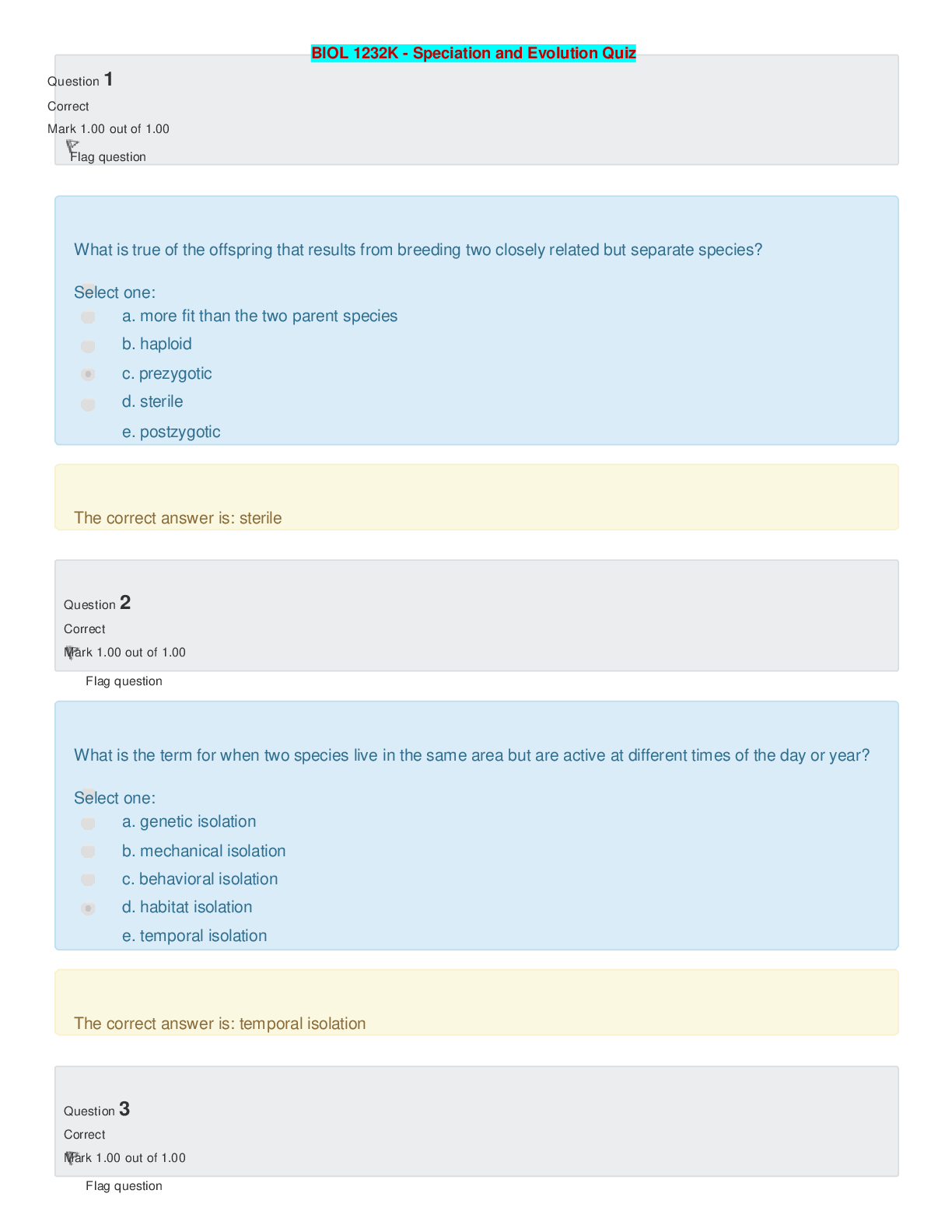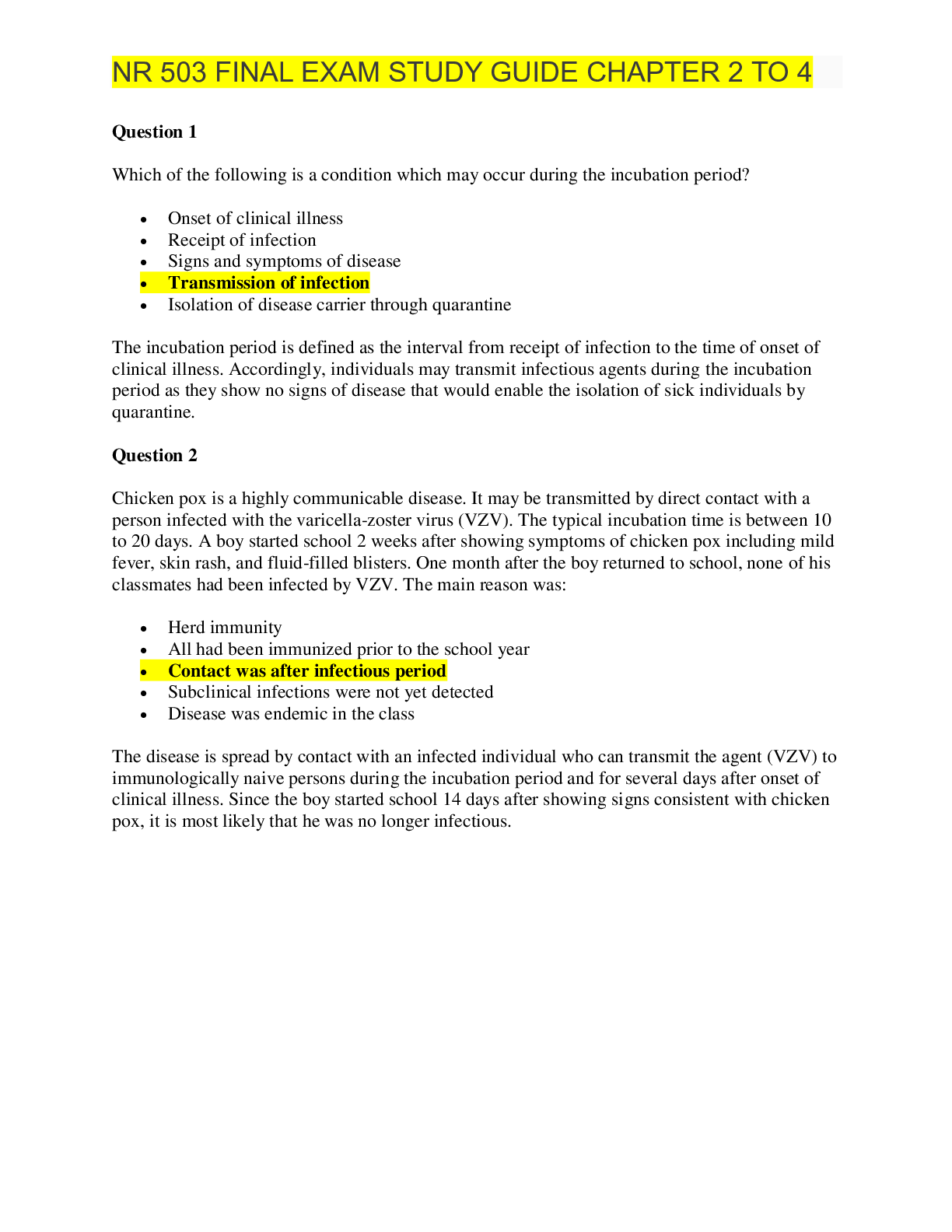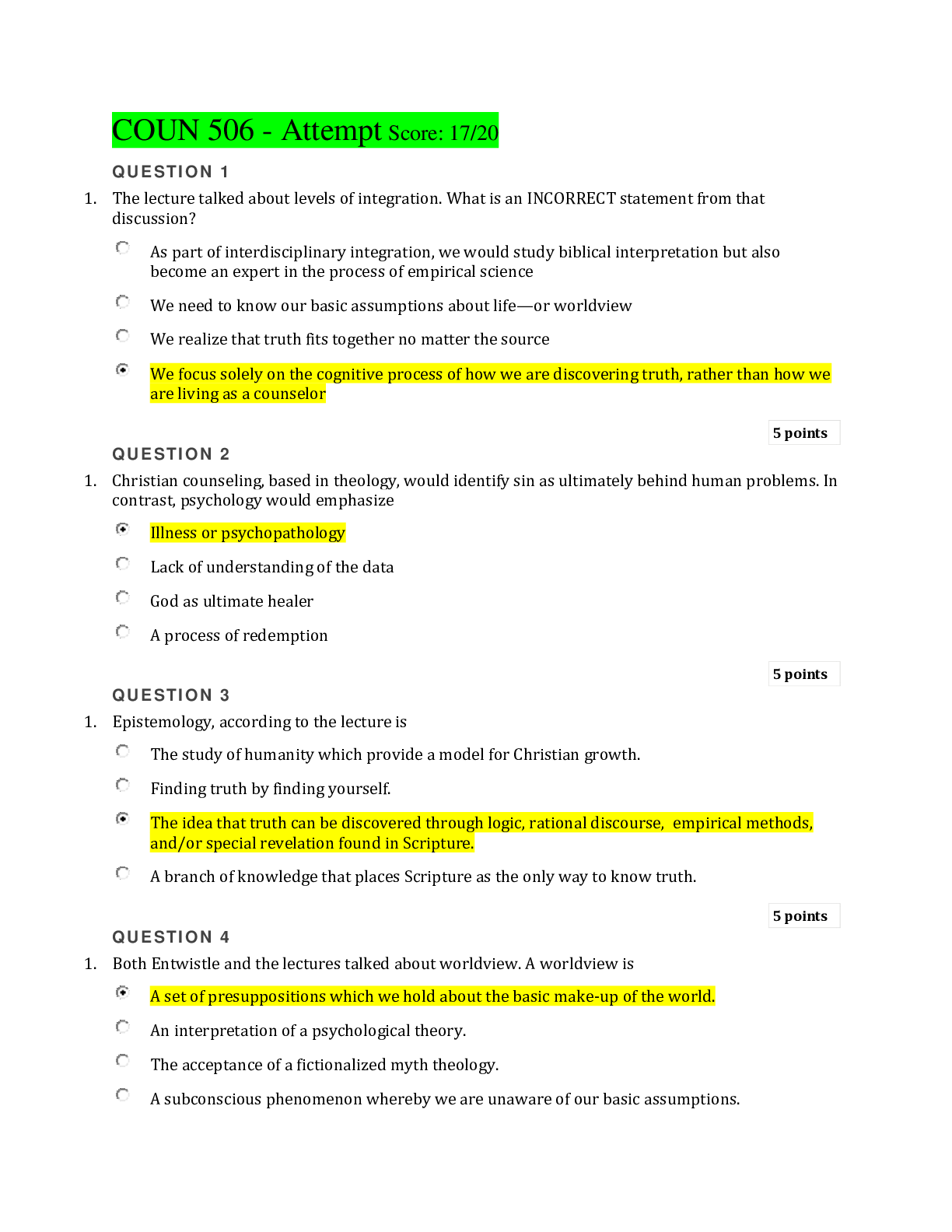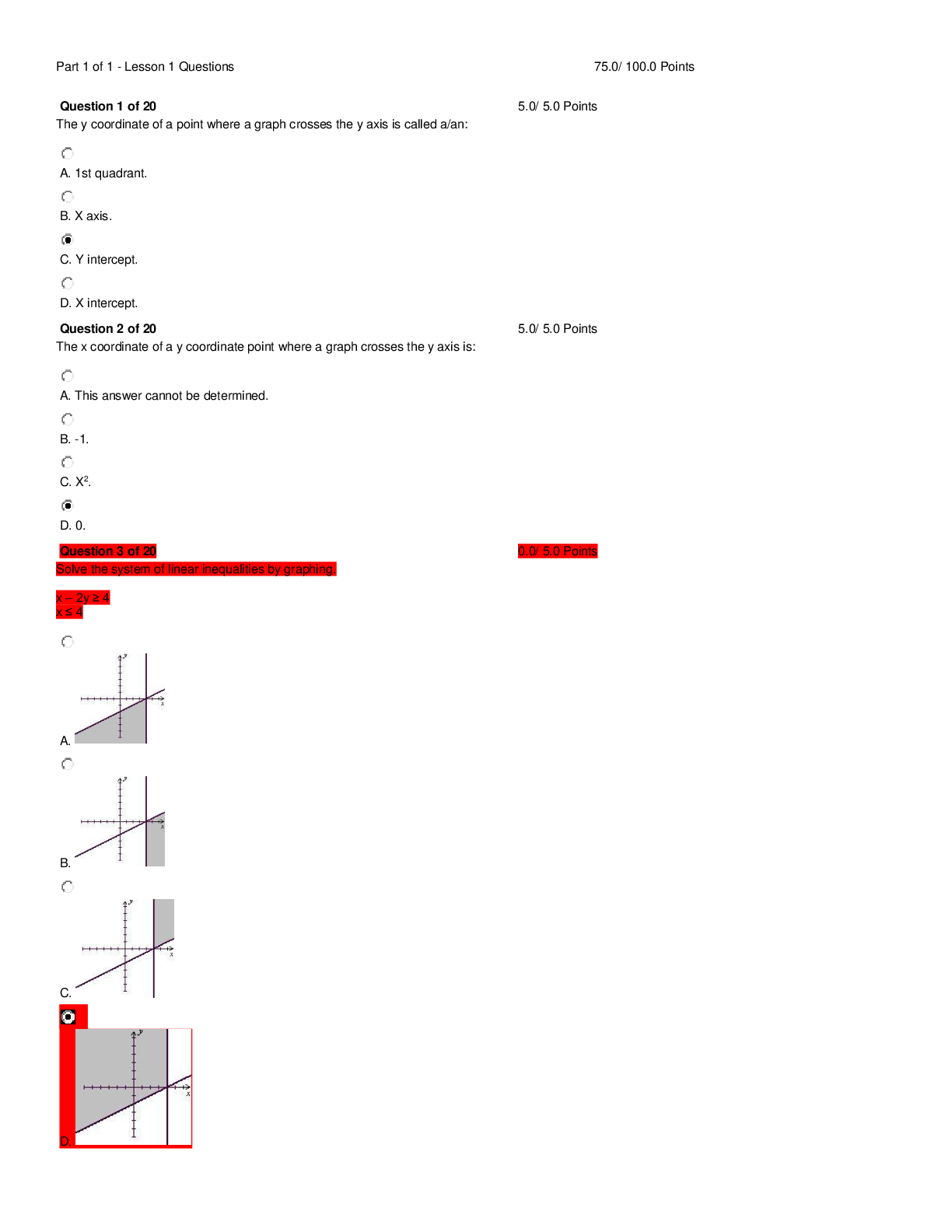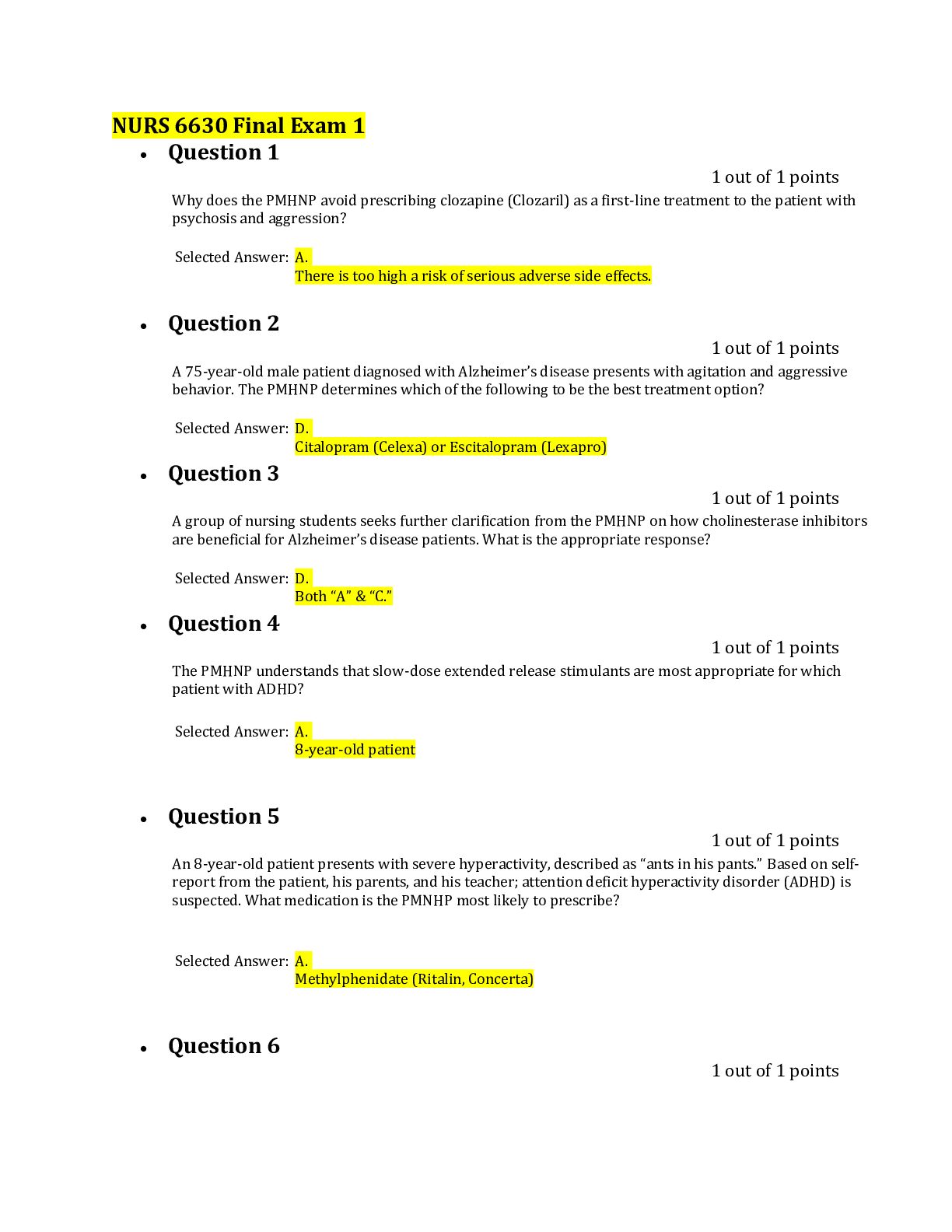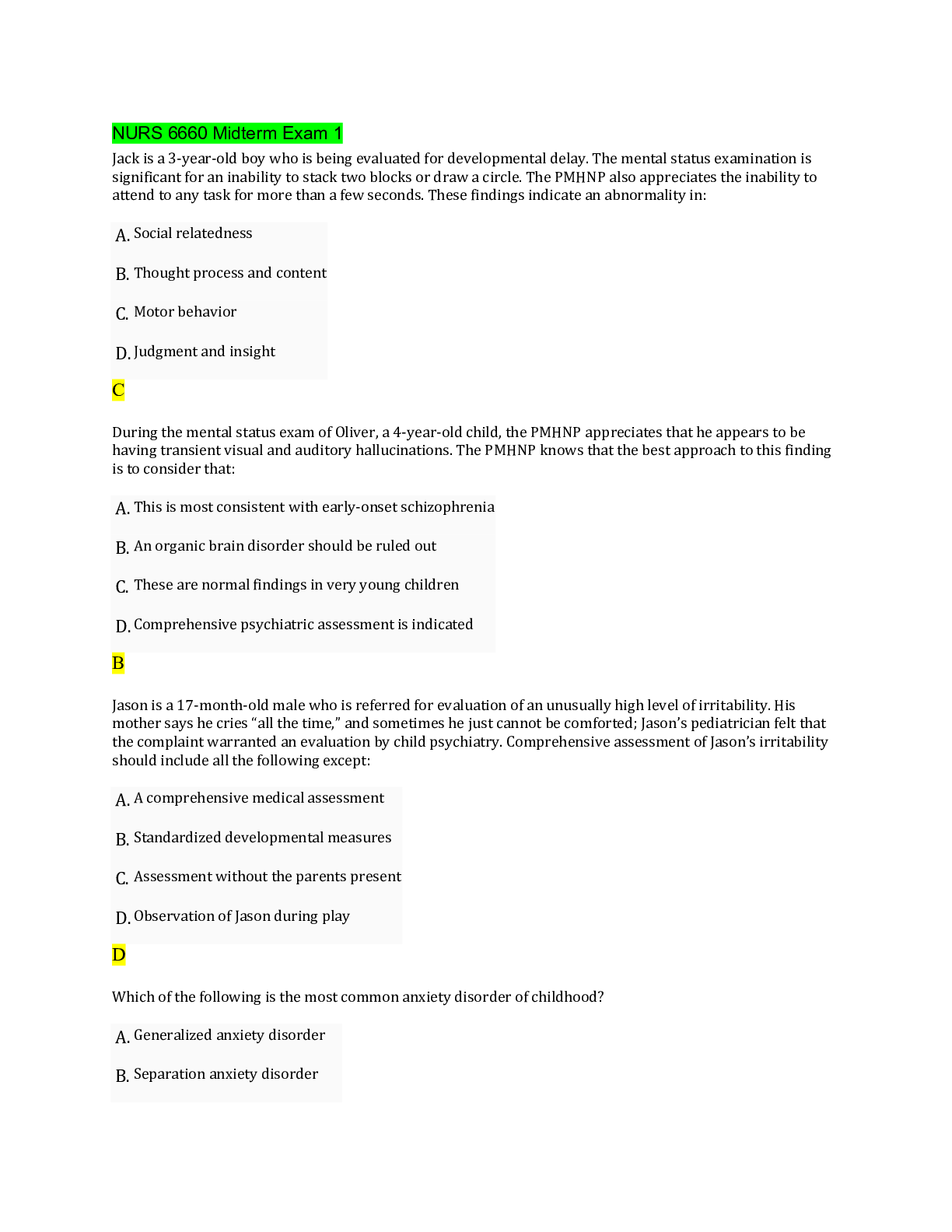NURS 3110 Exam 1 | Complete Solutions (Verified)
Document Content and Description Below
NURS 3110 Exam 1 | Complete Solutions (Verified) Bacteria and viruses are both capable of growing within a human host and causing disease. Which one of the following statements most accurately desc... ribes the features of bacteria and viruses? A. Bacteria have mitochondria allowing them to generate energy, whereas viruses are reliant on the host cell for energy. B. Because viruses lack a nucleolus, they can replicate independently of their hosts, whereas bacteria rely on host proteins to replicate their genomes. C. Bacterial ribosomes are composed of the same RNA and proteins as viral ribosomes. D. Viruses can only replicate within a cell, whereas bacteria can replicate independently of host cells. Bacteria, fungi (yeasts and molds), viruses, and protozoa are important causes of human diseases. Which one of the following microbes contains either DNA or RNA but not both? A. bacteria B. molds C. viruses D. protozoa E. yeasts Which one of the following contains DNA that is not surrounded by a nuclear membrane? A. bacteria B. molds C. protozoa D. yeasts Mycobacterium tuberculosis stains well with the acid-fast stain, but not with the Gram stain. Which one of the following is the most likely reason for this observation? A. It has a large number of pili that absorb the purple dye. B. It has a large amount of lipid that prevents entry of the purple dye. C. It has a very thin cell wall that does not retain the purple dye D. It is too thin to be seen in the Gram stain. E. It has histones that are highly negatively charged. Bacteria that cause nosocomial (hospital-acquired) infections often produce extracellular substances that allow them to stick firmly to medical devices, such as intravenous catheters. Which one of the following is the name of this extracellular substance? A. axial filament B. endotoxin C. flagella D. glycocalyx E. porin Several bacteria that form spores are important human pathogens. Which one of the following is the most accurate statement about bacterial spores? A. They are killed by boiling for 15 minutes. B. They are produced primarily by gram-negative cocci. C. They are formed primarily when the bacterium is exposed to antibiotics. D. They are produced by anaerobes only in the presence of oxygen. E. They are metabolically inactive, yet can survive for years in that inactive state. Match the following bacteria to the correct description. Bacteria: Staphylococcus, Clostridium, Neisseria, Mycobacterium, Yersinia Description: gram (-) cocci, acid fast, gram (+) spore forming anaerobic rod, gram (-) zoonotic rod, gram (+) cocci 1. staphylococcus= gram (+) cocci 2. clostridium= gram (+) spore forming anaerobic rod 3. Neisseria= gram (-) cocci 4. Mycobacterium= acid fast 5. Yersinia= gram (-) zoonotic rod Match the disease to the correct causative organism. Disease: Syphilis, Lyme disease, Cholera, Gonorrhea, Tetanus Causative Organism: Vibrio, Neisseria, Clostridium, Treponema, Borrelia 1. Syphilis= treponema 2. Lyme disease= Borrelia 3. Cholera= Vibrio 4. Gonorrhea= Neisseria 5. Tetanus= Clostridium Genome DNA sequencing is the current gold standard to classify organisms. True or False True The proteins on the external surface of viruses serve several important functions. Regarding these proteins, which one of the following statements is most accurate? A. They are the antigens against which neutralizing antibodies are formed. B. They are the polymerases that synthesize viral messenger RNA. C. They are the proteases that degrade cellular proteins leading to cell death. D. They are the proteins that regulate viral transcription. E. Change in conformation of these proteins can result in prion-mediated diseases such as Creutzfeldt-Jakob disease. A defective virus cannot synthesize a protein required for replication and therefore can only replicate within a cell infected by a helper virus. Which of the following is a defective virus? A. Hepatitis A virus B. Hepatitis B virus C. Hepatitis C virus D. Hepatitis D virus E. Hepatitis E virus Viruses contain both DNA and RNA. True or False False Regarding respiratory syncytial virus (RSV), which one of the following statements is most accurate? A. RSV is an important cause of bronchiolitis in infants. B. RSV causes tumors in newborn animals but not in humans. C. The RSV vaccine is recommended for all children prior to entering school. D. Amantadine should be given to elderly nursing home residents to prevent outbreaks of disease caused by RSV. E. RSV forms intranuclear inclusion bodies within neutrophils that are important in diagnosis by the clinical laboratory. Regarding Coronavirus Disease-19 (COVID-19) caused by SARS-CoV-2, which one of the following statements is most accurate? A. Symptoms of COVID-19 are limited to the lower respiratory tract. B. Asymptomatic infections rarely occur. C. The laboratory diagnosis can be made by either detection of viral RNA or detection of antibodies to the spike protein. D. Oseltamivir, a neuraminidase inhibitor, is used to treat severe COVID-19 disease. E. A vaccine that protects against COVID-19 contains the messenger RNA encoding the SARS-CoV-2 spike protein. Match the virus to the disease is causes. Virus: Herpes Simplex Virus, Varicella-Zoster Virus, Epstein-Barr Virus, Human Herpesvirus 8, Rhinoviruses Disease: Infectious Mononucleosis, Kaposi's sarcoma, Common Cold, Chickenpox, Herpes labialis 1. Herpes Simplex Virus= Herpes labialis 2. Varicella-Zoster Virus= Chickenpox 3. Epstein-Barr Virus= Infectious Mononucleosis 4. Human Herpesvirus 8= Kaposi's sarcoma 5. Rhinoviruses= Common cold Which of the following bests defines the term bacteriostatic? A. Bacteria can no longer be eradicated by a specific antibiotic. B. The range of antibiotic activity. C. A laboratory test that determines which antibiotics will successfully treat a specific infection. D. An agent which inhibits the growth of bacteria. E. An agent which kills bacteria. Which of the following is the most important measure of infection control? A. hand hygiene B. Disinfection of patient rooms C. Face shields and masks D. Safe injection practices E. Contact precautions Which of the following conditions require contact precautions? Select all that apply. A. A rash with open lesions B. Draining wounds C. Influenza D. Infectious diarrhea E. Measles Which of the following patients require standard precautions? Select all that apply. A. A patient hospitalized for appendicitis B. A patient hospitalized for pneumonia C. A patient hospitalized for a fractured hip D. A patient hospitalized for an exacerbation of asthma E. A patient hospitalized for a myocardial infarction Handwashing is an important means of interrupting the chain of transmission from one person to another. Infection by which of the following bacteria is most likely to be interrupted by handwashing? A. Borrelia burgdorferi B. Legionella pneumophila C. Staphylococcus aureus D. Streptococcus agalactiae (group B Streptococcus) E. Treponema pallidum Vertical transmission is the transmission of organisms from parent to fetus or newborn child. Infection by which of the following bacteria is most likely to be transmitted vertically? A. Chlamydia trachomatis B. Clostridium tetani C. Haemophilus influenzae D. Shigella dysenteriae E. Streptococcus pneumoniae The cells involved with pyogenic inflammation are mainly neutrophils, whereas the cells involved with granulomatous inflammation are mainly macrophages and helper T cells. Infection by which of the following bacteria is most likely to elicit granulomatous inflammation? A. Escherichia coli B. Mycobacterium tuberculosis C. Neisseria gonorrhoeae D. Streptococcus pyogenes E. Staphylococcus aureus Which of the following applies to COVID-19? Select all that apply. A. Communicability B. Toxigenicity C. Virulence D. Pathogenicity E. Infectivity Which of the following are signs of the inflammatory response? Select all that apply. A. redness B. swelling C. heat D. pallor E. emesis Humoral immunity involves which of the following? Select all that apply. A. Memory B lymphocytes B. B lymphocytes C. T lymphocytes D. Helper T cells E. Cytotoxic T cells Which of the following classes of antibiotics are considered the safest? A. penicillin B. tetracycline C. macrolide D. aminoglycoside Which of the following organisms is not a parasite? A. Nematodes B. Giardia lamblia C. Candida albicans D. Toxoplasmosis gondii Which statement about viral infections and/or their pharmacologic treatment is false? A. Some viral infections are associated with malignancy. B. Medications used to treat viral infections often interact with other medications. C. Some viral infections are associated with birth defects in a fetus. D. Resistance is not a problem with antiviral medications like it is with antibiotics. Which of the following do all bacteria have in common? A. they are all the same shape B. they all require a cell wall C. they all need oxygen to reproduce D. they are all gram negative Which of the following do Clostridium species and Anthrax have in common? A. the ability to form spores B. they are both aerobic bacteria C. they all cause tetanus D. they all cause food poisoning E. their toxoids all have pharmacologic use Which organism causes the infection seen in the picture? A. staph aureus B. strep pneumoniae C. herpes simplex D. clostridium botulinum What is illustrated in this picture? A. a Bull's eye lesion B. a laceration C. a positive tuberculin skin test D. a birthmark What is illustrated in the picture? Select all that apply. A. herpes zoster B. shingles C. an infection due to varicella virus D. a severe sunburn E. poison ivy What organism is responsible for the infection seen in this image? A. candida B. staph C. tinea D. herpes simplex Identify Candida. A. bacteria B. virus C. parasite D. fungi Identify Herpes. A. bacteria B. virus C. parasite D. fungi Identify Trichomonas. A. bacteria B. virus C. parasite D. fungi Identify Strep. A. bacteria B. virus C. parasite D. fungi On which of the following would it be appropriate to use a disinfectant? Select all that apply. A. surgical wounds B. exam tables C. intact skin D. surgical instruments E. counter tops Which of the following disorders involve the inflammatory response? Select all that apply. A. appendicitis B. sprained ankle C. COVID-19 infection D. rheumatoid arthritis E. gout Which of the following signs and symptoms are characteristics of inflammation? Select all that apply. A. swelling B. shortness of breath C. nausea & vomiting D. redness E. itching Which of the following is the best initial treatment of acute, localized inflammation? A. ice B. heat C. ibuprofen D. acetaminophen Which of the following was thought to be an advantage of COX-2 inhibitors vs aspirin or NSAIDs? A. cost B. less risk of upper GI bleeding C. more potent anti-inflammatory effects D. safety Which of the following is associated with corticosteroid use? Select all that apply. A. hypertension B. diabetes C. growth delay in children D. cataract formation E. asthma Which of the following are benefits of treatment with acetaminophen? Select all that apply. A. cost B. anti-inflammatory properties C. liver toxicity D. no risk of upper GI bleeding Which of these infections would stimulate memory B lymphocytes to provide lifelong immunity? A. the common cold B. influenza C. chickenpox D. COVID-19 What category would COVID-19 vaccines fall into? A. attenuated B. inactivated C. toxoid D. recombinant Which of the following best described the roles of T and B lymphocytes? A. cytotoxic and helper T cells along with B lymphocytes directly kill bacteria B. cytotoxic and helper T cells along with B lymphocytes are all involved in antibody production C. cytotoxic and help T cells provide cell-mediated immunity while B lymphocytes provide humoral immune responses D. cytotoxic and helper T cells provide humoral immune responses while B lymphocytes provide cell-mediated immunity Why are flulike symptoms likely side effects of immunostimulant therapy? A. stimulation of innate immune responses B. stimulation of memory B lymphocytes C. stimulation of T lymphocytes D. antibody production Which of the following nosocomial infections are now commonly found in the community? Select all that apply. A. MRSA B. VRE C. C. diff D. CRE Which of the following scenarios best describes a superinfection? A. an infant taking amoxicillin for an ear infection develops oral thrush B. a pt needs to take 2 different antibiotics for a wound infection based on a culture and sensitivity of the wound C. a young woman taking oral contraceptives is advised to use a back up method of birth control when prescribed doxycycline for Lyme disease. D. culture and sensitivity shows a patient presumptively treated with sulfamethoxazole-trimethoprim needs a different antibiotic for treatment of a UTI Which of the following is true about penicillin class antibiotics? Select all that apply A. a broad-spectrum penicillin has limited clinical utility B. penicillin class antibiotics have an excellent safety profile C. penicillin class antibiotics may be used in children & pregnant women D. penicillin was 1st mass produced after WW2 Which of the following is false regarding cephalosporin antibiotics? A. subsequent generations of cephalosporins are broader spectrum than earlier generations B. vaginal yeast infections commonly occur in women prescribed a cephalosporin antibiotic C. cephalosporin antibiotics are safe for children and pregnant women D. all patients with a penicillin allergy are allergic to cephalosporins Which of the following is false regarding tetracycline antibiotics? A. tetracycline is effective for treating Lyme disease as well as genitourinary infections such as chlamydia B. tetracycline causes weakening and straining of dentin C. tetracycline is bactericidal D. medications such as antacids can interfere with the absorption of tetracycline antibiotics Which of the following severe adverse events occur with macrolide antibiotics but not penicillin or cephalosporin antibiotics? A. QT prolongation B. superinfection C. anaphylaxis D. pseudomembranous colitis Which of the following is true regarding aminoglycoside antibiotics? A. aminoglycoside antibiotics are commonly prescribed oral antibiotics B. aminoglycoside antibiotics are common found in OTC anti-infective topical products C. aminoglycoside antibiotics don't have any Black Box Warnings D. aminoglycoside antibiotics are 1stline treatments fur UTIs caused by E. coli Which of the following is a Black Box Warning for all fluroquinolone antibiotics? [Show More]
Last updated: 2 months ago
Preview 4 out of 18 pages

Loading document previews ...
Buy this document to get the full access instantly
Instant Download Access after purchase
Buy NowInstant download
We Accept:

Also available in bundle (1)

NURS 3110 EXAM 1 & 2 BUNDLE
NURS 3110 EXAM 1 & 2 BUNDLE
By Nurse Henny 2 months ago
$20
2
Reviews( 0 )
$16.00
Can't find what you want? Try our AI powered Search
Document information
Connected school, study & course
About the document
Uploaded On
Mar 18, 2025
Number of pages
18
Written in
Additional information
This document has been written for:
Uploaded
Mar 18, 2025
Downloads
0
Views
15



